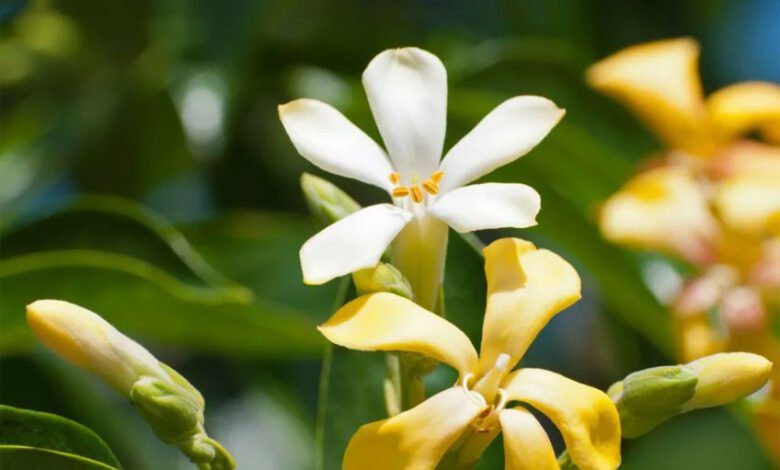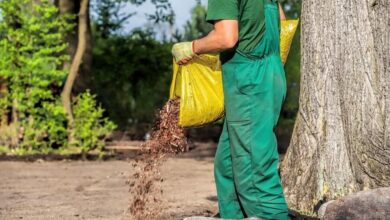A Complete Guide to Grow Australian Native Frangipani

The sweet fragrance of the Australian Native Frangipani evokes imagery of idyllic natural landscapes filled with vibrant yellow blooms. This iconic native plant is a jewel of Australia’s diverse flora. With its graceful form and beautiful flowers, the Australian Native Frangipani deserves a spot in every Aussie garden.
Introduction
The Australian Native Frangipani, also known as Hymenosporum flavum, is an evergreen tree or shrub that is endemic to the eastern coastal regions of Australia. It earned the common name “Native Frangipani” due to its flowers bearing resemblance to frangipani varieties from other parts of the world. However, the Australian Native Frangipani is a distinct species with its unique characteristics.
This plant has long been treasured by gardeners for its ability to infuse spaces with sweet floral fragrance and visual delight. The Australian Native Frangipani’s graceful form and profusions of small yellow blooms make it a staple inclusion in gardens across Australia. Beyond beauty, cultivating native plants like the Australian Native Frangipani also brings environmental benefits by providing habitat and food sources for local fauna while requiring less maintenance compared to exotic varieties.
Understanding the Australian Native Frangipani
The Australian Native Frangipani is an evergreen shrub or small tree that typically grows to 6-10 feet tall and 4-8 feet wide when mature. The leaves are a rich green color comprised of slender leaflets arranged in a fern-like pattern. From summer through fall, this plant unleashes an abundance of small yellow flowers that emit an intensely sweet, frangipani-like scent.
Here is a comparison of some defining features of the Australian Native Frangipani versus other frangipani varieties:
| Plant Variety | Max Height | Flower Color | Climate Tolerance | Growth Rate |
|---|---|---|---|---|
| Australian Native Frangipani | 10 ft | Yellow | Withstands light frost | Slow |
| Common Frangipani | 30 ft | Various colors | Frost tender | Fast |
| Hawaiian Frangipani | 20 ft | Pastel varieties | Withstands light frost | Moderate |
As displayed in the table, the Australian Native Frangipani remains relatively compact and adapts better to cooler climates compared to the common and Hawaiian frangipani varieties which originate from tropical regions. These traits make the Australian native an ideal choice to incorporate as a landscape focal point even where space is limited. It also supports local ecological communities, unlike exotic varieties.
“The Australian Native Frangipani holds great environmental significance by attracting crucial pollinators and providing shelter and food sources that sustain local biodiversity within ecosystems.” – Laura Jones, Habitat Restoration Biologist
Optimal Planting Conditions
To enable the Australian Native Frangipani to thrive, certain site characteristics and planting conditions must be met.
The Australian Native Frangipani prefers well-drained and slightly acidic soil with a pH between 6.1-6.5. Waterlogging severely damages its health, so ensure the site does not collect excessive moisture. Sandy loam or clay loam soils amended with compost provide an ideal medium for growth.
These plants require full sun for abundant flowering and optimal growth habit. Provide a minimum of 6 hours of direct sun exposure. Light afternoon shade can be tolerated once established but may reduce blooms.
The Australian Native Frangipani is adaptable to USDA Hardiness Zones 9-11, enduring light frost and brief drops to 15-25°F when mature. It thrives in warm, subtropical or Mediterranean climates that receive over 30 inches of rainfall annually. Growing this plant in excessively hot, arid regions is challenging. Select sites with some natural air flow and humidity.
Step-by-Step Planting Guide
Preparing the site and carefully planting the Australian Native Frangipani helps create the conditions for health and vigor. Here is a walkthrough to ensure proper establishment:
Prepare the soil by mixing quality compost or aged manure throughout the top 12-18 inches of native soil to bolster nutrients and drainage. Remove any weeds, rocks, or roots that may impede growth. Amend acidic soils with elemental sulfur.
Dig a hole as deep and 2-3 times as wide as the plant’s root ball. Roughen its sides for better anchoring and backfill with the amended native soil.
“Planting a tree is the first step towards nurturing nature.” – Martha Stewart, American entrepreneur & lifestyle icon
Carefully place the root ball in the hole, positioning the plant at its original growing depth. Backfill soil around it, tamping lightly to stabilize. Build a watering basin around the perimeter to help concentrate irrigation.
Water thoroughly until moist throughout the root zone. Provide follow-up deep waterings during dry periods for the first two years until extensively established. Adding organic mulch helps retain soil moisture.
Proper site selection paired with attentive planting allows Australian Native Frangipanis the conditions to maximize their grace and flower production.
Care and Maintenance
Caring for Australian Native Frangipani involves providing ample sunlight, managing watering needs, fertilizing appropriately, and strategic pruning.
Watering is crucial during the Australian Native Frangipani’s establishment phase. Provide deep irrigation allowing the top 12 inches of soil to dry out slightly between waterings. Mature plants tolerate some drought but produce more flowers with consistent moisture.
Fertilize Australian Native Frangipanis in early spring using a balanced 10-10-10 or bloom-boosting fertilizer following label rates. Avoid over-fertilizing which can damage plant health. Repeat with a half-strength application in midsummer if growth appears slowed.
Pruning accelerates bushy growth in Australian Native Frangipanis while controlling size. Annually trim back upright branches behind latent buds. Remove crossed branches and interior twiggy growth to open the canopy. Shape as needed after the flowering period ends. Disinfect shears between cuts.
By addressing water, nutrient, and light penetration needs, the Australian Native Frangipani will be primed to unleash its signature floral display.
Pest and Disease Management
The Australian Native Frangipani possesses reasonable pest and disease resistance if provided appropriate care. However, several potential issues can compromise plant health which require monitoring and management:
Frangipani Caterpillars feed on leaves and burrow into stalks, causing extensive defoliation. Hand pick caterpillars wearing gloves. Spray Bacillus thuringiensis as an organic control measure.
Scales feast on sap and excrete sticky honeydew residue. Rub off visible scales. Apply horticultural oil or insecticidal soap sprays focusing on stem joints and leaf undersides where scales congregate.
Root Rot Fungus develops from excessive moisture. Improve drainage and reduce irrigation frequency. Dispose infected plants properly.
By scouting regularly and quickly addressing any threats detected through organic or least toxic solutions, the Australian Native Frangipani’s glorious display can persevere in gardens. Preventative cultural methods like providing adequate sunlight and air circulation also bolster this plant’s defenses.
Encouraging Blooming
The Australian Native Frangipani unleashes sprays of small, bright yellow blooms under optimum conditions. Here are key strategies for achieving prolific flowering:
Sunlight exposure directly fuels the energetic demands of flowering. Ensure plants receive at minimum 6 hours of unfiltered sun daily. Supplemental feeding may help compensate for insufficient light.
Adequate water prevents drought stress which can inhibit bud formation. Target an inch of water weekly during spring and summer through irrigation/rainfall. Avoid saturating the root zone.
Fertilizing with phosphorus-rich formulations in early spring reservations the energy needed for profuse blooming. Apply an all-purpose or bloom booster fertilizer.
With its needs met for light, water and nutrients, the Australian Native Frangipani generously rewards gardeners with an abundance of sweetly-scented golden-yellow blooms.
Australian Native Frangipani in Landscape Design
The Australian Native Frangipani brings impactful visual interest and alluring fragrance to garden designs. Consider incorporating this graceful native plant in the following ways:
- Use as a fragrance focal point near patios or walkways where its floral perfume can best be appreciated
- Combine with bird and butterfly-attracting flowers like agapanthus, pentas and butterfly bush which complement its nectar-rich blooms
- Underplant with blue-hued companions like rosemary, blue fescue and agapanthus to create color contrast with its vibrant yellow blossoms
- Train as a small flowering tree to showcase the shapely form and drooping foliage
- Plant in clusters or mass as a flowering backdrop hedge to define garden spaces with all-season color and texture
The Australian Native Frangipani is a versatile choice that earns its place through every season, unlikeephemeral bloomers. It brings enduring beauty as a stand-alone specimen or integrated harmoniously into the landscape palette.
Conservation and Sustainability
The importance of native plants like the Australian Native Frangipani extends beyond aesthetics by bringing immense ecological value. This plant contributes to habitat conservation efforts by:
- Providing vital pollen and nectar to support bees, butterflies and other pollinators
- Offering shelter and nesting sites for small native birds and mammals
- Serving as a food source for native fauna that adapted to this endemic species
- Stabilizing local soil systems through extensive root networks while needing minimal watering and maintenance
Gardeners can employ sustainable methods to aid this native plant’s success:
- Apply organic mulch to suppress weeds, slow water evaporation d and enrich the soil
- Utilize rainwater harvesting techniques to provide irrigation without depleting reserves
- Deadhead spent flowers to encourage continuous blooming and propagate new plants The Australian Native Frangipani is a champion of environmental resilience. Incorporating this adaptable native into our gardens facilitates conservation in our backyards.
Conclusion
For Australian gardening enthusiasts, few native plants offer the virtues of beauty, adaptability and rich sensory appeal quite like the Australian Native Frangipani. With its gracefully arching canopy draped in sweetly-fragrant golden blooms through warm seasons, this floral icon imparts cherished character to any garden. The Australian Native Frangipani also carries profound ecological symbolism by bringing life and habitat to local fauna while requiring fewer resources to thrive in its native climate. Experiencing the daily delights this giving tree bestows fully reveals why it has earned pride of place in Australian gardens for generations.
By welcoming the Australian Native Frangipani’s graceful presence, we invest in the continuity of our rich natural heritage.
FAQs
What is the best time to plant the Australian Native Frangipani?
The ideal time to plant the Australian Native Frangipani is in early spring once the danger of frost has passed. This allows the plant time to establish before heat arrives.
Where is the best location to plant the Australian Native Frangipani?
Select a spot with full sun exposure for a minimum of 6 hours daily that has well-draining soil. Protect from strong winds.
What is the watering frequency for the Australian Native Frangipani?
Water young plants 1-2 times a week, allowing the soil to slightly dry between waterings. Mature plants need infrequent but deep weekly soakings of around 1 inch during warm months.
How often should I fertilize my Australian Native Frangipani?
Fertilize once in early spring with a balanced fertilizer following package rates. Reich fertilizing is generally not needed but a second, half strength application can boost flowering if desired.
What is causing yellow leaves on my Australian Native Frangipani?
Yellow leaves usually indicate overwatering issues leading to root rot. Check that the soil drains well and reduce watering frequency. Remove any diseased sections promptly.
Why is my Australian Native Frangipani not blooming?
Insufficient sunlight, overpruning, overfertilizing, drought stress and pest damage can inhibit flowering. Review care practices and remedy any issues present.
Should I prune my Australian Native Frangipani?
Pruning immediately after flowering finishes controls size and promotes bushy new growth. Remove crossing, dead or diseased branches. Avoid pruning late summer to prevent disrupting bud development.
How do I propagate the Australian Native Frangipani?
Take 10-12 inch stem cuttings from new growth in spring/summer. Dip in rooting hormone then insert in potting mix, keeping humid until rooted. Seeds are challenging to germinate.



